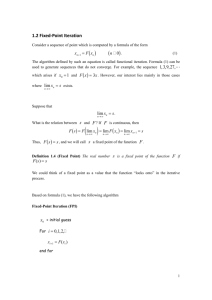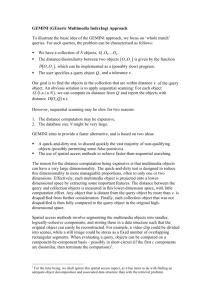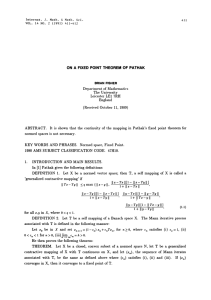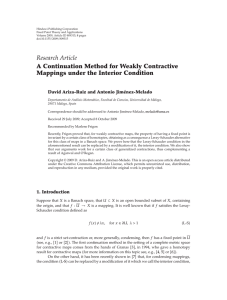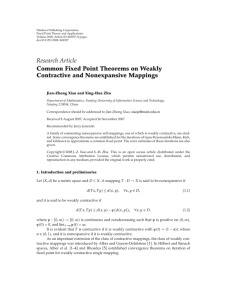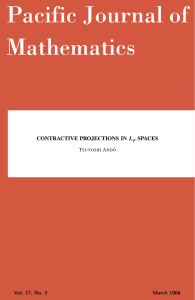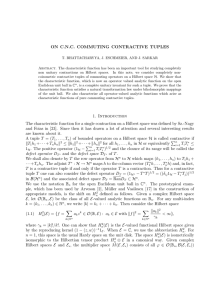Document 10440374
advertisement
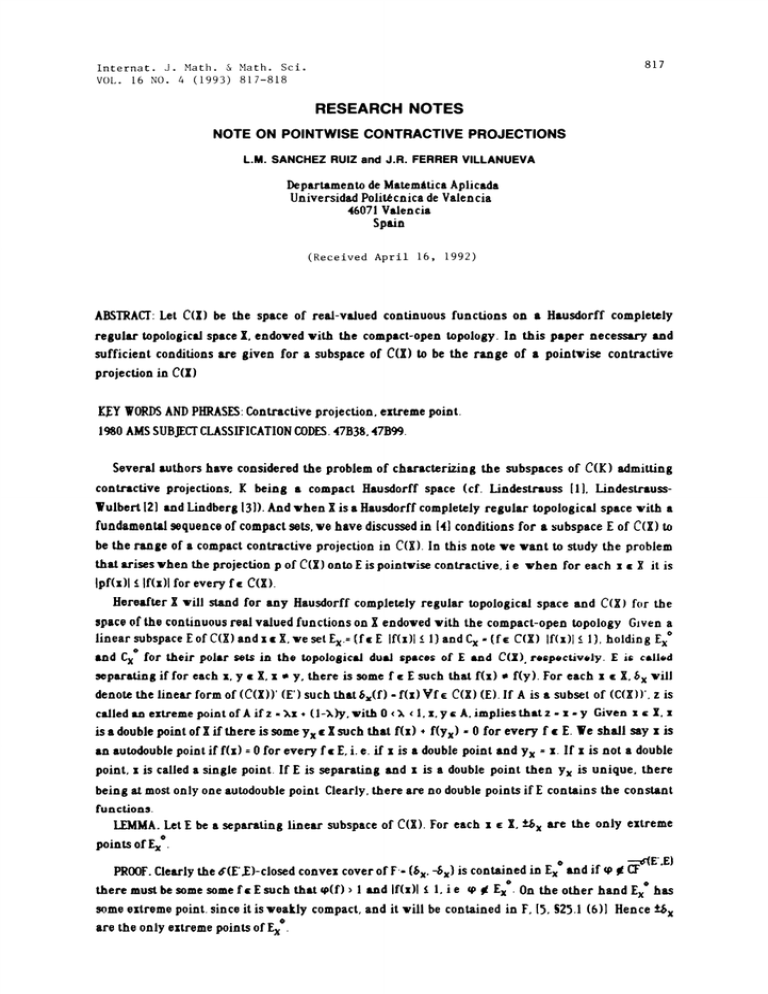
817
Internat. J. Math. & Math. Sci.
VOL. 16 NO. 4 (1993) 817-818
RESEARCH NOTES
NOTE ON POINTWISE CONTRACTIVE PROJECTIONS
L.M. SANCHEZ RUIZ and J.R. FERRER VILLANUEVA
Departamento de MatemAtica Aplicada
Universidad Politecnica de Valencia
46071 Valencia
Spain
(Received April 16, 1992)
ABSTRACT: Let C(X) be the space of real-valued continuous functions on a Hausdorff completely
regular topological space X. endowed with the compact-open topology. In this paper necessary and
sufficient conditions are given for a subspace of C(X) to be the range of a pointwise contractive
projection in C(X)
K]Y WORDS AND PHRASES: Contractive projection, extreme point.
1980 AMS SUBJCI" CLASSIFICATION CODES. 47B38.47B99.
Several authors have considered the problem of characterizing the subspaces of C(K) admitting
contractive projections. K being a compact Hausdorff space (cf. Lindestrauss [I]. LindestraussWulbert [7] and Lindberg [3]). And when X is a Hausdorff completely regular topological space with a
fundamental sequence of compact sets, we have discussed in [4] conditions for a subspace E of C(X) to
be the range of a compact contractive projection in C(X). In this note we want to study the problem
that arises when the projection p of C(X) onto E is pointwise contractive,
when for each
X it is
Ipf(x)l <- If(x)l for every f C(X).
Hereafter X will stand for any Hausdorff completely regular topological space and C(X) for the
space of the continuous real valued functions on X endowed with the compact-open topology Given a
linear subspace E of C(X) and X, we set Ex.= {f E If(x)l <- l} and Cx (f C(X) If(x)l < l}, holding Ex
and Cx for their polar sets in the topololical dui spaces of E and C(X), repectiv,Jy. E i cll,,d
X, will
separating if for each x, y X, ,, y, there is some f E such that f(x)., f(y). For each
denote the linear form of (C(X))’ (E’) such that 6,,(f) -f(x) Vf C(X) (E). If A is a subset of (C(X))’. z is
X.
called an extreme point of A if z ,x (l-,)y, with 0
1. x. y = A. implies that z. y Given
is a double point of ] if there is some Yx I X such that f(x) f(Yx) "0 for every f E. We shall say is
an autodouble point if f(x) 0 for every f E, i. e. if is a double point and Yx x. If is not a double
point, x is called a single point. If E is separating and x is a double point then Yx is unique, there
x
.
,
being at most only one autodouble point Clearly. there are no double points if E contains the constant
functions.
LEMMA. Let E be a separating linear subspace of C(X). For each
e.
points of Ex
X, +-b x are the only extreme
.
o
---’E’.E)
PROOF. Clearly the 6(E’)-closed convex cover of F-- (&x. -x) is contained in Ex and if q)
q Ex On the other hand E has
and If(x)l I,
there must be some some f E such that q(f)
some extreme point, since it is weakly compact, and it will be contained in F, [5, S25.1 (6)] Hence
o
are the only extreme points of Ex
x"
x
818
L.M. SANCHEZ RUIZ AND J.R. FERRER VILLANUEVA
PIOPOSITION. Let E be a separating subspace of C(X) and p a pointwise contractive projection of
C(X) onto E Then for each
X, the transpose linear mapping p" of p satisfies
i) p’(6 x) 0 if is an autodouble point
ii) p’(5 x) =5 x if is not an autodouble point
PROOF. i) For each f C(X), p’Bx(f) Bx(pf) (pf)(x) 0 since pf E. Hence p’(Bx 0
o
ii) Let E(x).= {q) Cx
f)x) which, by Krein-Millman’s theorem, coincides with the closed
q)lE
convex cover of its extreme points Now p’f)x E() since for each g Cx, Ip’f)x(g)l 16x(Pg)l
I Ig(x)l 1, and for each f E, p*)x(f) )x(pf) x(f) Besides, each extreme point of E() is an
@
o
extreme point ofC x since if q)san extreme point ofE(x)and q)=(xu (l-o)v’, u’, v" Cx then 6 x
o
and u’, v" belong to E() and
Ex. So. 6x
(l-(x)v’l., where
eIE xu’lE,
u’lE, vl.
u’l. v’l,
coincide with q) Therefore, by Proposition 1, q) =o:6 x with 1 1. As x is not autodouble, there is some
f E such that 0 f(x) Bx(f) which, takin into account that e E(), takes the same value as q)(f)
(XBx(f) =(xf(x) Hence (x and P"f)x
From this Proposition it follows that if z is an autodouble point, then z is tn isolated point since if
is
x the function identically one on ], (pl]{)(x) x(plx) (p6x)(l x) Bx(lX) for each z. and
=0, Moreover, for each
, z the equation f(z)
.
fly) 0 Vf E has no solution since plx E
z is a double point. Consequently,
’THEOREM 1. Let E be a separating subspace of C(X) and p a pointwise contractive projection of
onto E. Then
i) If for each x X there is some f E such that f{x) 0. every point of I is single.
ii) If there is some
X such that f() 0 for etch f E, is the only double point of X, Moreover
(plx)(z)
and no point
is isolated and, clearly, autodouble.
THEOREM 2. A locally convex topological vector space E is isomorphic to the range of a pointvise
contractive projection in C(X) if and only if E is isomorphic to either C(X) or some Cz(X) (f
f(z) O),zI.
PROOF. Assume E is separating. If each point X is single, pf(z) x(pf) p’x(f) =x(f) f(z) for
every f C(X) So f pf E. On the other hand, if there exists some double point z. E is contained in
Cz(X). But for each f Cz(X), pf(z) 0 and pf(x) f(x) for x, z. If E is not separating, we are able to
form the quotient by identifying those points which are not separated by E and the same conclusion
yields.
Conversely, ifE is isomorphic to some Cz(X), then the mapping p C(X)-+ z(X) defined by p(f)
where fz(s) "f(x) for
z and fz(z) 0, is pointwise contractive and pf f for each f Cz(X)
,
c
LINDESTRAUSS, J, Extension of compact operators, Mere. Amer. Math Soc. 48 (1964).
7,
LINDESTRAU$$, J. and
WULBKRT, e.. On the classification of the Banach spaces whose duals are
spaces, .L. ]unct. Anal. 4 (1969), 332-349
L!
3,
LINDBERG K Contractive Projections in Continuous Function Spaces, Proc. Amer. Math Soc. 36
(1972), 97-I03
4,
FKRRER VILLANUEVA, J.R.; LOPE PELLICER, M and SANCHEZ RUIZ, L,M, Compact Contractive
Proiections in Continuous Function Spaces,
Math..L. 38 1991 ), 395-400
5,
KOTHE, G,: To_oolocal Vector S.gay._L Springer-Verlag. Berlin, Heidelberg, New York 1969

